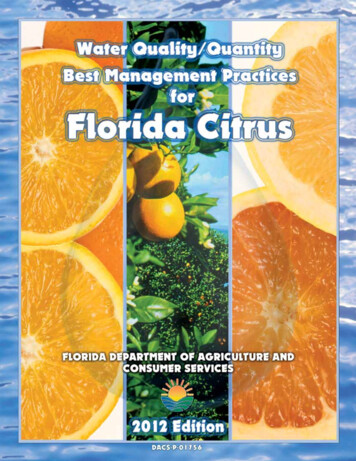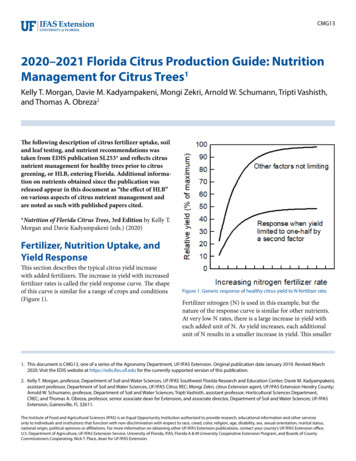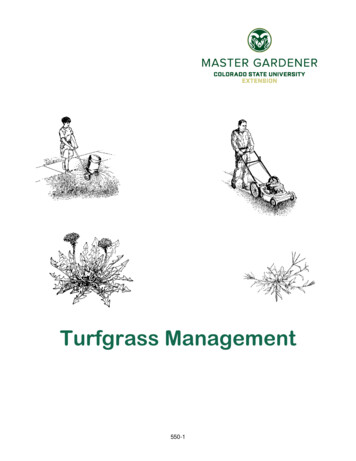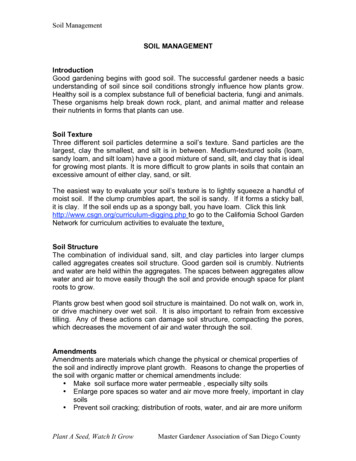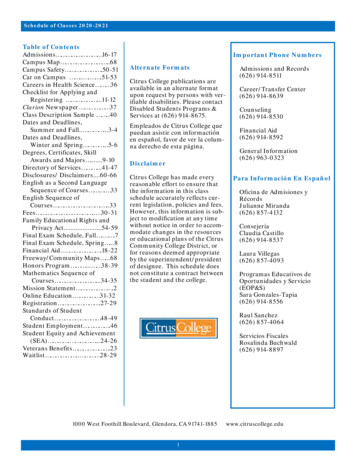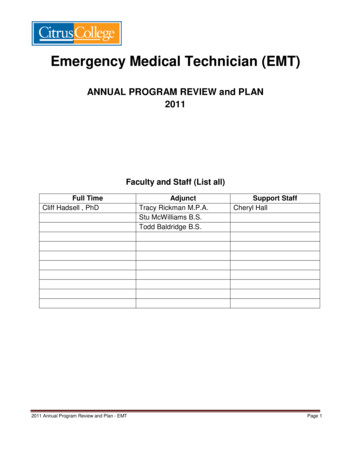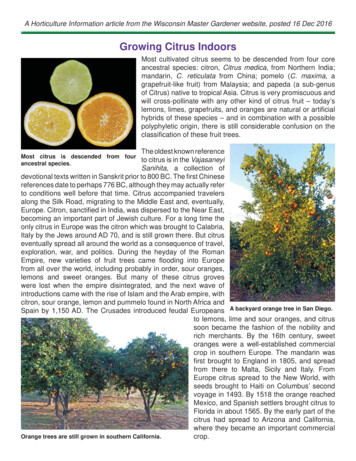
Transcription
A Horticulture Information article from the Wisconsin Master Gardener website, posted 16 Dec 2016Growing Citrus IndoorsMost cultivated citrus seems to be descended from four coreancestral species: citron, Citrus medica, from Northern India;mandarin, C. reticulata from China; pomelo (C. maxima, agrapefruit-like fruit) from Malaysia; and papeda (a sub-genusof Citrus) native to tropical Asia. Citrus is very promiscuous andwill cross-pollinate with any other kind of citrus fruit – today’slemons, limes, grapefruits, and oranges are natural or artificialhybrids of these species – and in combination with a possiblepolyphyletic origin, there is still considerable confusion on theclassification of these fruit trees.The oldest known referenceto citrus is in the VajasaneyiSanihita, a collection ofdevotional texts written in Sanskrit prior to 800 BC. The first Chinesereferences date to perhaps 776 BC, although they may actually referto conditions well before that time. Citrus accompanied travelersalong the Silk Road, migrating to the Middle East and, eventually,Europe. Citron, sanctified in India, was dispersed to the Near East,becoming an important part of Jewish culture. For a long time theonly citrus in Europe was the citron which was brought to Calabria,Italy by the Jews around AD 70, and is still grown there. But citruseventually spread all around the world as a consequence of travel,exploration, war, and politics. During the heyday of the RomanEmpire, new varieties of fruit trees came flooding into Europefrom all over the world, including probably in order, sour oranges,lemons and sweet oranges. But many of these citrus groveswere lost when the empire disintegrated, and the next wave ofintroductions came with the rise of Islam and the Arab empire, withcitron, sour orange, lemon and pummelo found in North Africa andSpain by 1,150 AD. The Crusades introduced feudal Europeans A backyard orange tree in San Diego.to lemons, lime and sour oranges, and citrussoon became the fashion of the nobility andrich merchants. By the 16th century, sweetoranges were a well-established commercialcrop in southern Europe. The mandarin wasfirst brought to England in 1805, and spreadfrom there to Malta, Sicily and Italy. FromEurope citrus spread to the New World, withseeds brought to Haiti on Columbus’ secondvoyage in 1493. By 1518 the orange reachedMexico, and Spanish settlers brought citrus toFlorida in about 1565. By the early part of thecitrus had spread to Arizona and California,where they became an important commercialOrange trees are still grown in southern California.crop.Most citrus is descended from fourancestral species.
Many types of citrus can grow more than 20 feet tall in the ground, but dwarf types can be kept at 3-5feet tall in containers. These trees have ovoid to elongate, glossy, dark green leaves. On many typesof citrus the leaf has a small flange along the petiole. There are some cultivars with variegated foliage.Citrus leaves (L) often have a flange on the petiole (LC) and may be dark or light green (RC) or variegated (R).Citrus often has thorns at the nodes, especially on new graftsand fruiting wood; these can be cut off if desired (if the thornsare on shoots that originate from the rootstock, below the graftunion, the entire shoot should be removed). Thorns evolvedfor protection from herbivores, especially of the young foliagewhich is most delicate, so many types only have thorns asjuveniles but outgrow them as the tree matures. Lemonsand limes generally have sharp thorns, although thornlesscultivars are available – but they supposedly have less flavorand are not as productive. Some orange cultivars only haveMany types of citrus have sharpt thorns.small, blunt thorns at the base of the leaves.Clusters of fragrant white flowers are produced at the ends of the stems. Depending on variety, mostcitrus trees bloom in spring to set fruit that are ready to harvest in fall and winter. Others may flowerand fruit off and on year-round (especially lemons, limes and kumquats), and specific pruning andClusters of buds (L), which may be white or pink (LC) open to white petals and yellow stamens (C, RC and R).Young fruits develop after the flowers.fertilization techniques can promote flowering in the offseason. These are followed by a fruit technically calleda hesperidium, a specialized type of berry with a leatheryrind called a pericarp. Because most citrus doesn’t requirecross pollination to be productive (although it may increasefruit size), they will set fruit on a single plant indoors. Pottedtrees often set much more fruit than the tree can support,so fruit drop is very common. The time from blossom to
fruit harvest varies by type and variety. In general, most lemons andlimes ripen in six to nine months, while oranges take about a year. Citrusfruits ripen only on the tree, but can remain on the tree in good conditionlong after they are mature.Once the exotic fruit was brought to the attention of the wealthy, it began tobe grown in nearly every European palace and garden either for culinaryuse, medicine or just for decoration. Since citrus is not frost hardy, incold climates, including central and northern Italy and France, treeshad to be grown in containers and spend the winter in the shelter of apurpose-built structure called an orangerie (orange house) in French andCitrus fruits are a hesperidium,limonaia (lemon house) in Italian. These special structures are intended a specialized type of berry withto protect the citrus a leathery rind.from freezing andprovide reasonable light, keeping them cool sothey don’t grow too much during the winter. Theorangery at the gardens of Versailles, with morethan 1,000 potted plants, might be the world’s mostfamous showcase of citrus trees, indoors or out.During the Renaissance it was fashionable amongrich families to collect rare mutations of citrus trees.Villa Medici di Castello in Florence, Italy has part ofthe original Medici citrus collection, with a geneticline that goes back hundreds of years. Some ofthese unusual cultivars, such as “fingered lemons”,Part of the citrus collection at Villa Medici di Castello.can still be seen in Tuscan gardens.An assortments of citrus fruits, including fingered lemons (second from right).Even without an orangerie or limonaia, citrus is easily grown in containers incold climates. The plants can remain outdoors during the growing season, butmust be brought indoors when temperatures approach freezing. In Italy andFrance citrus often need to be sheltered in the relatively dim light of orangeor lemon houses only for a few months, but in harsher climates the plants willneed to remain indoors for longer and will need bright light to thrive.For the best success growing citrus as a houseplant, place the container wherethe plant will receive as bright light as possible, such as in a south or southwestfacing window. Citrus trees do not go dormant like many other plants, so theyneed sufficient light and some humidity during the winter (although their growthwill slow during this time). Supplemental light will be needed for fruit productionif the plants do not receive at least 6 hours of direct light daily (the foliageCitrus growing in a largecan adapt to the relatively low light levels typical in a home, but plants arecontainer in Italy.
very unlikely to flower). Citrus grow best between 55 F and 85 F.They can tolerate warmer or cooler temperatures (down to aboutfreezing or below depending on the variety) for very short periodsof time, but avoid abrupt temperature shifts. They require a 5-10degree difference in day and night temperatures for flowering.Once temperatures are consistently above 50 F citrus trees canbe moved outdoors for the growing season. Acclimate them over aperiod of one to two weeks, gradually moving from a sheltered, partlyshaded spot into full sun (leaves will sunburn if moved too quicklyfrom low light conditions in a house to full sun; drastic changesof environment can also cause leaves, flowers and young fruit todrop). Choose a sunny location that isn’t too windy and where thecontainers will not be standing in water or receive frequent, shallowwatering (such as near a lawn with a sprinkler system). Warmermicroclimates, such as near a building or where there is reflectedheat from a patio or walkway, are good choices. Move them backindoors before night temperatures drop into the 40s.Citrus in containers are best movedoutside once the weather is warm.Grow all types of citrus in a slightly acid, well-drained pottingmedium, such as cactus mix. Amending regular commercial potting medium with up to 1/3 small peagravel, pumice, turkey grit and/or other inorganic materials will improve the drainage. Avoid usinggrowing media formulated for moisture retention. Clay, plastic or decorative containers are all suitable,as long as there are sufficient drainage holes. Start plants insmaller pots and move to a larger size as they grow so thatthere isn’t too much potting medium relative to the amount offoliage (or the soil will remain too wet after watering, makingroot rot more likely). A deep pot is better than a shallowone, as it will balance the tree when it gets larger and moretop-heavy. Citrus can be kept in 10-12 inch pots for severalyears. Larger containers will allow the tree to grow biggerand more productive, but these may be harder to move.Plants should be repotted every year or two.Citrus trees require soil that is moist but never soggy. Waterregularly as needed to keep the potting medium moist,but not wet, allowing it to dry slightly between waterings.Grow citrus in well-drained potting medium Infrequent, deep watering is preferable to frequent, shallowand keep it moist, but not wet.applications. The amount and frequency needed will dependon the size of the container and plant, they potting medium, temperature, humidity and other factors.Cupped or yellowed leaves can be a symptom of excessive watering. Reduce watering in winter whenplants are not actively growing.Citrus are heavy feeders and need more nitrogen than phosphorus or potassium. Specialized citrus/avocado fertilizers are available, but any all-purpose or acid-loving plant fertilizer that supplies at leasta 2-1-1 ratio can be used. Trace minerals including iron, zinc and manganese may need to be added(most multipurpose fertilizers contain these minerals). Granular, slow release formulations are best, butfrequent, dilute applications of soluble fertilizer can be made when plants are actively growing (Aprilthrough September). Yellowing leaves may indicate a need for more fertilizer.
The most common pests on citrus trees in the Midwest are brown softscale and two-spotted spider mite, and occasionally aphids, mealybugs,or whiteflies. Washing the foliage periodically can help deter thesepests. Insecticidal soap or synthetic insecticides can be used againstall of these, although physically wiping the scales off the leaves andbranches may also be needed as any sprays will only kill the crawlerstage of that insect. Light horticultural oil may also be effective againstscales. With all of these pests, multiple applications may be requiredto achieve control.Although citrus can be grown from seed, those plants will be differentfrom the parents, so it is best to purchase a known variety. Cultivarscan also be propagated from semi-soft stem cuttings taken in thespring or summer – commercial varieties are almost also grafted aswell, with a rootstock thatis different from the cultivargrafted on top. Any suckers(shoot growth below the Cottony cushion scale is angraft union – a diagonal scar important pest of citrus, but in thebetween 4 and 8 inches from Midwest brown scale and spiderthe soil) should be removed mites are the most common pests.immediately to prevent vigorous growth that will detractfrom fruiting wood. Citrus can be pruning any time to shapeand balance the tree. Lemon trees can even be trained asbonsai specimens. Most varieties of commercial oranges andother citrus grown outdoors in warm climates are too largeto be grown indoors. Dwarf cultivars – or those on dwarfingCitrus grown from seed is unlikely to rootstocks that keep the plant small – are especially suited forproduce the same type of fruit as the parent. growing in containers.Sweet citrus – such as oranges and tangerines – need a lot of heat to ripen, whereas the acid citrus –lemons and limes – need much less, so are more easily grown indoors. These types not only ripen theirfruit much faster, but also tend to be nearly ever-blooming. Some of the easiest include:Bearss lime (C. x latifolia) – also known as Tahitian lime and Persian lime, is a vigorous, thornlesstree that produces bigger fruit than Mexican limes.Calamondin (Citrofortunella microcarpa or Citrus madurensis) – is grownprimarily as an ornamental, producing small, round, orange, sour fruit.‘Peters’ is a variegated form.Citron (Citrus medica) – has yellow fruit with a rough and bumpy surface,very thick and fleshy rind, little juice, and sweet flavor.Kaffir lime (C. hystrix) – is grown for the leaves that are used in Thai andother Southeast Asian, but it does produce a small, bumpy fruit.‘Eureka’ lemon – is a thornless cultivar with full size, striped fruitKumquat (Fortunella spp.) – has flowers with a pungent sandalwood-likescent followed by small, elongate, tart orange fruits good for marmalade.Meiwa kumquat (F. crassifolia) has round and sweet fruits.Limequat – a hybrid of Mexican lime and kumquat (C. aurantiifolia x F.crassifolia) with a shrub-like habit and yellow, egg-sized fruit with edibleskin.Variegated calamondin.
Mandarin or satsuma oranges (C. reticulata) — aren’t really oranges at all but tangerines notedfor their abundant fragrant flowers and which require far less heat to ripen the sweet fruit than trueoranges.‘Meyer’ lemon – a lemon-orange hybrid brought from China in 1908 that produces very juicy,medium-sized, seedless fruits with a very thin skin and sweeter pulp than other types of lemons.The Improved Meyer Lemon is virus-free (the original was a symptomless carrier of certain viruses,particularly tristeza).Tahitian orange (Citrus limonia ‘Otaheite’) – a dwarf, thornless tree that should be properly regardedas an acidless or sweet form of the Rangpur lime.‘Trovita’ orange (C. sinensis) – is fast-ripening with medium-small, few-seeded juicy fruit, but tendstoward alternate bearing.– Susan Mahr, University of Wisconsin – MadisonAdditional Information:Growing citrus indoors in Minnesota – University of Minnesota Extension article H106C at ing Citrus Indoors in Cool Climates – Purdue University Consumer Horticulture at https://hort.purdue.edu/ext/citrus.htmlCitrus Trees: an Ideal Indoor Plant Selection – by a MGV for Colorado State University CooperativeExtension at s.htmGrowing Indoor Citrus – by GrowOrganic on YouTube at https://www.youtube.com/watch?v tNivqIKI 9gIndoor Citrus and Fruit trees – a commercial site at http://www.indoorcitrustrees.com/University of California Riverside Citrus Variety Collection – for citrus variety characteristics,hardiness and harvest seasons at http://www.citrusvariety.ucr.edu
along the Silk Road, migrating to the Middle East and, eventually, Europe. Citron, sancti fi ed in India, was dispersed to the Near East, becoming an important part of Jewish culture. For a long time the only citrus in Europe was the citron which was brought to Calabria, Italy by the Jews around AD 70, and is still grown there. But citrus
